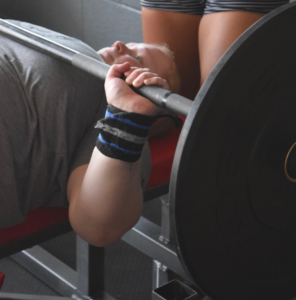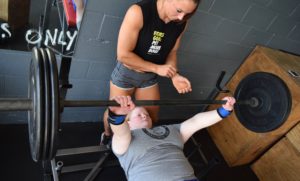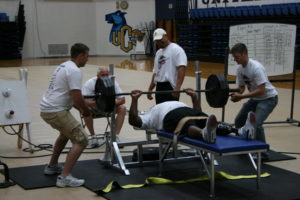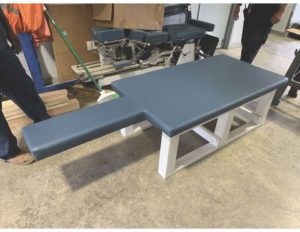Para Powerlifting
You are lying on a bench. You reach up to grab the bar that is nestled on the rack. You bring the bar off the rack, descend it to your chest evenly and ascend it back up before putting the bar back in the rack. In essence, and in the simplest terms, that is the sport of para lifting.
THE BASICS
 Powerlifting, often intertwined with other names like para lifting or para bench, is a competitive sport. It has been a Paralympic sport since 1984. Whether or not you strive to pursue the sport competitively at the national or international level, you can derive many benefits from participating in this activity.
Powerlifting, often intertwined with other names like para lifting or para bench, is a competitive sport. It has been a Paralympic sport since 1984. Whether or not you strive to pursue the sport competitively at the national or international level, you can derive many benefits from participating in this activity.
Kelli Anne Stallkamp, a member of Move United’s Elite Team, started powerlifting as a cross training activity for sled hockey originally. She was good at sled hockey, playing on the Women’s National Sled Hockey team for two years. In 2018, she started powerlifting for fun. “I fell in love with the sport,” Stallkamp said. Her first competition took place at the Great Lakes Games, hosted annually in the Chicago area by the Great Lakes Adaptive Sport Association (GLASA), a member of the Move United network. At that event, she qualified for Junior Nationals and the rest is history.
Many athletes, like Stallkamp first did, use powerlifting as a means rather than an end. Whether you call it powerlifting, weightlifting, or strength and conditioning (sometimes these terms are interchanged), you may engage in the activity as part of your routine to train for other sports, to stay healthy, or concentrate on increasing your muscular endurance, strength, tone, or mass. You may frequent a gym to do so or may have access to your own equipment at home.
TO BE (COMPETITIVE) OR NOT TO BE (COMPETITIVE)
 One of the reasons Stallkamp was drawn to the sport is because it is an individualized activity. “It is up to you to perform when it comes to a sport like powerlifting,” she said. It truly is the ultimate test of upper body strength.
One of the reasons Stallkamp was drawn to the sport is because it is an individualized activity. “It is up to you to perform when it comes to a sport like powerlifting,” she said. It truly is the ultimate test of upper body strength.
The para element of powerlifting focuses only on the bench press. We have all probably seen a typical bench press. Typically, an athlete is lying on a very narrow bench with their feet on the ground and knees at a 90-degree angle. “Para bench is much like AB (able bodied) bench,” according to Mary Hodge, the high-performance coach for US Paralympic Powerlifting, which is headquartered at Logan University. “But, the legs are not on the floor and the bench is about two feet longer and a foot wider.”
To compete, an athlete must have an impairment in their lower limbs or hips and have one (or more) of the eight eligible physical impairments. Some examples, include but are not limited to, spinal cord injuries, spina bifida, congenital limb deficiency, lower limb amputation, cerebral palsy, bone shortening, or multiple sclerosis.
Legs are not supposed to move at all during the press, according to Stallkamp. “This ensures an equal playing field,” she said. In order to be on the same level based on gender and body weight class, an athlete can choose to use up to two straps for the legs. You can strap above the ankle and below the knee and above the knee and below the groin. But straps are not required.
“Strategically, most athletes would take away an advantage by not using a strap, at least until they get experienced enough not to move their legs,” said Hodge. “Because no part of your body can move other than your upper body, which is hard to maintain when you are pushing a lot of weight off your chest.”
“The whole lower body from hips down is essentially out in this sport. It becomes a sport of upper body strength. From your core, if you have the ability to use your core (stomach area) and up (arms, shoulders, and back) is the game.”
MORE THAN POWER AND STRENGTH
Although the focus is on strength and power, powerlifting is also about control. A typical press or lift looks like this:
Once you are on the bench, strapped in and given the goahead, you unrack the bar (or a head spotter can take the bar out of the rack for you). You bring the bar out and wait for the start command from the head referee. Then you can descend the bar to your chest. “It must descend to your chest evenly. It can’t drop too quickly,” Hodge said. You then hold the bar motionless around the pectoral area. It can’t sink, can’t bounce, can’t be uneven or ladder from side to side. Once the motion has stopped, then you can ascend the bar back up, hold it still at the top with both hands together until you hear the rack command, and then place the bar back in the rack.
“Your emotions and feelings have to be under control,” Hodge states. “If you have too much anxiety or too much adrenaline, you are going to move too fast and make a mistake.” Those mistakes may lead to you not having a good lift. There are three referees, one above your head and two to the sides past your knees, who determine if you have a clean lift by issuing a red or white light. You need two white lights, but three is perfect.
 For Stallkamp, her focus is often on the mental side of the sport. “Most people think it is a physical sport, but it also a mental one,” she said. “You are the only one on stage and all eyes are on you.”
For Stallkamp, her focus is often on the mental side of the sport. “Most people think it is a physical sport, but it also a mental one,” she said. “You are the only one on stage and all eyes are on you.”
In a competition, the winner is the person who lifts the most weight in their bodyweight category. Each athlete gets three attempts to lift their maximum weight. “For some, it is just about lifting the bar (without any weights added), which is 40 pounds,” says Stallkamp. “It really depends on your level of ability.”
For competitive paralifting, you do have to be able to wrap your thumb and all the other fingers around the bar, for safety. But other adaptations can be made by individual athletes. Individuals with a spinal cord injury or spina bifida may not be able to use their core. But there are other things you can do, including widening your grip to have more stability or widen your legs to give you a wider base. “It means you work a little harder with your upper body,” Hodge said.
LEARN MORE
Powerlifting is one of the fastest growing adaptive sports. Hodge recommends prospective athletes should first come to a USA Para Powerlifting (USAPP) Level One course, where you will get a good overview of the sport. In the session, everything from medical, nutrition, classification, training, and more is covered. Visit logan.edu/usapp for more details.
Patience and time and effort is often required. “Everyone wants to make a Paralympic team,” Hodge said. “It is not an overnight thing … it often takes years of training.” To learn more, she suggests checking out USAPP videos on YouTube or disabledpowerlifting.com.
Para Powerlifting Competition Rules and Records
- 2024 Move United Para Powerlifting Rulebook
- Move United National Para Powerlifting Records
- U.S. Paralympics Powerlifting
- World Para Powerlifting Rules and Regulations
Para Powerlifting Competition Resources
- USA Para Powerlifting: Kit Check – Inspection Sheet
- USA Para Powerlifting Abbreviated Attempt Card
- Score Sheet


